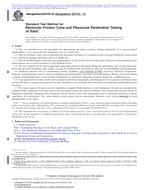Potrebujeme váš súhlas na využitie jednotlivých dát, aby sa vám okrem iného mohli ukazovať informácie týkajúce sa vašich záujmov. Súhlas udelíte kliknutím na tlačidlo „OK“.
ASTM D5778-12
Standard Test Method for Electronic Friction Cone and Piezocone Penetration Testing of Soils
Automaticky preložený názov:
Štandardná skúšobná metóda pre elektronické trenie kužeľ a Piezocone Penetračné testy zemín
NORMA vydaná dňa 1.1.2012
Informácie o norme:
Označenie normy: ASTM D5778-12
Poznámka: NEPLATNÁ
Dátum vydania normy: 1.1.2012
Kód tovaru: NS-32510
Počet strán: 20
Približná hmotnosť: 60 g (0.13 libier)
Krajina: Americká technická norma
Kategória: Technické normy ASTM
Kategórie - podobné normy:
Anotácia textu normy ASTM D5778-12 :
Keywords:
cone penetration test, cone penetrometer, explorations, field test, friction resistance, geotechnical test, in-situ testing, penetration tests, penetrometer, piezocone, point resistance, porewater pressures, resistance, sleeve friction, soil investigations , Cone penetrometer test, Electronic friction cone, Explorations, Field testing--soil, Friction cone penetrometers, Penetration--soil, Penetrometer testing, Piezocone penetration, Soil, Sounding, Subsurface investigation--soil/rock
Doplňujúce informácie
| Significance and Use | ||||||||||
|
Tests performed using this test method provide a detailed record of cone resistance which is useful for evaluation of site stratigraphy, homogeneity and depth to firm layers, voids or cavities, and other discontinuities. The use of a friction sleeve and porewater pressure element can provide an estimate of soil classification, and correlations with engineering properties of soils. When properly performed at suitable sites, the test provides a rapid means for determining subsurface conditions. This test method provides data used for estimating engineering properties of soil intended to help with the design and construction of earthworks, the foundations for structures, and the behavior of soils under static and dynamic loads. This method tests the soil in-situ and soil samples are not obtained. The interpretation of the results from this test method provides estimates of the types of soil penetrated. Engineers may obtain soil samples from parallel borings for correlation purposes but prior information or experience may preclude the need for borings. Note 3—The quality of the results produced by this standard is dependent on the competence of the personal performing the test, and the suitability of the equipment and facilities used. Agencies that meet the criteria of Practice D3740 are generally considered capable of competent and objective testing/sampling/inspection/etc. Users of this standard are cautioned that compliance with Practice D3740 does not in itself assure reliable results. Reliable results depend on many factors and Practice D3740 provides a means of evaluating some of those factors. |
||||||||||
| 1. Scope | ||||||||||
|
1.1 This test method covers the procedure for determining the point resistance during penetration of a conical-shaped penetrometer as it is advanced into subsurface soils at a steady rate. 1.2 This test method is also used to determine the frictional resistance of a cylindrical sleeve located behind the conical point as it is advanced through subsurface soils at a steady rate. 1.3 This test method applies to friction-cone penetrometers of the electric and electronic type. Field tests using mechanical-type penetrometers are covered elsewhere by Test Method D3441. 1.4 This test method can be used to determine porewater pressures developed during the penetration, thus termed piezocone. Porewater pressure dissipation, after a push, can also be monitored for correlation to time rate of consolidation and permeability. 1.5 Additional sensors, such as inclinometer, seismic geophones (Test Methods D7400), resistivity, electrical conductivity, dielectric, and temperature sensors, may be included in the penetrometer to provide useful information. The use of an inclinometer is highly recommended since it will provide information on potentially damaging situations during the sounding process. 1.6 Cone penetration test data can be used to interpret subsurface stratigraphy, and through use of site specific correlations, they can provide data on engineering properties of soils intended for use in design and construction of earthworks and foundations for structures. 1.7 The values stated in SI units are to be regarded as standard. Within Section 13 on Calculations, SI units are considered the standard. Other commonly used units such as the inch-pound system are shown in brackets. The various data reported should be displayed in mutually compatible units as agreed to by the client or user. Cone tip projected area is commonly referred to in square centimetres for convenience. The values stated in each system are not equivalents; therefore, each system shall be used independently of the other. Note 1—This test method does not include hydraulic or pneumatic penetrometers. However, many of the procedural requirements herein could apply to those penetrometers. Also, offshore/marine CPT systems may have procedural differences because of the difficulties of testing in those environments (for example, tidal variations, salt water, waves). Mechanical CPT systems are covered under Test Method D3441. 1.8 This standard does not purport to address all of the safety concerns, if any, associated with its use. It is the responsibility of the user of this standard to establish appropriate safety and health practices and determine the applicability of regulatory limitations prior to use. |
||||||||||
| 2. Referenced Documents | ||||||||||
|
Podobné normy:
Historická
15.1.2014
Historická
1.7.2007
Historická
1.2.2014
Historická
1.5.2007
Historická
15.8.2013
Historická
1.5.2010



 ASTM D5779/D5779M-14..
ASTM D5779/D5779M-14.. ASTM D5852-00(2007)..
ASTM D5852-00(2007).. ASTM D5873-14
ASTM D5873-14 ASTM D5874-02(2007)..
ASTM D5874-02(2007).. ASTM D6035/D6035M-13..
ASTM D6035/D6035M-13.. ASTM D6067-10
ASTM D6067-10
 Cookies
Cookies
